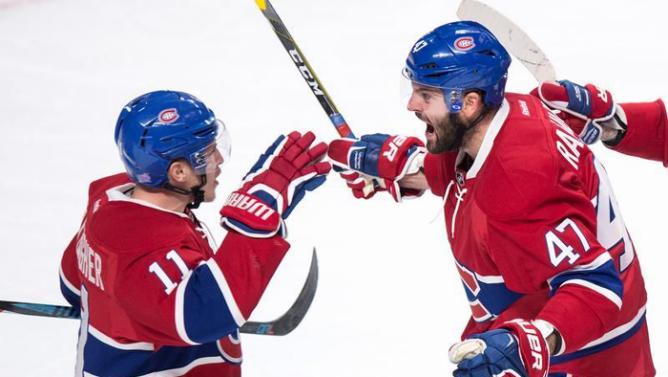
 Ian Boisvert
Rabid Habs
Ian Boisvert
Rabid Habs
54
Reads
0
Comments
In the Zone: Breaking Down the Habs’ Power Play

When Kirk Muller was brought in by the Canadiens, the expectation was that the Habs’ power play would be among the league’s best, just like it had been under Muller and Guy Carbonneau. The Habs’ 20.1% conversion rate on the power play is good for 11th in the league. I’m not a math whiz, but if Montreal gets five power plays every game, they would score a power play goal every game.
So why does the power play seem so ineffective?
Here comes the #Habs Powerplay! pic.twitter.com/bS4LpnornN
— Ian
(@BoisvertIan) December 18, 2016
I’m not a big “Xs and Os” guy, but I decided to break down some film; about 13 power plays in all. What I found was that the Habs’ success on the power play had nothing to do with offensive zone play; it lives and dies with zone entries. This should go without saying, but in order to establish an attacking zone presence, a successful entry into the zone is necessary.
The Canadiens were successful at entering the attacking zone when they had three things: possession, speed and support.
To illustrate what I mean, let’s first take a look at some unsuccessful zone entries.
Unsuccessful Zone Entries
Dec. 10 vs. Colorado
Although the Canadiens dominated almost every aspect of this game, there is always room for improvement. Take, for example, their first power play. After a Weber shot from the point, the Habs lose the zone. Their first attempt to enter the zone failed.
As always, click on each photo for an enlarged image.
As Markov carries the puck to center, he drops the puck back to Radulov. At this point, Radulov is the only player moving. Radulov’s only option is a pass to Shaw, which is quickly broken up. This play fails due to the Canadiens’ lack of speed through the neutral zone, the lack of possession while crossing the blue line, and the lack of support for Shaw, who quickly loses the puck.
The Canadiens tried again, with a similar result.
Markov gains center on his own, and makes a lateral pass to Pacioretty on the left wall. Pacioretty isn’t moving, so the entire rush slows to his pace. Pacioretty then tries to pass the puck to Radulov, which fails. Markov had speed initially, but his pass to a stationary Pacioretty stopped the entry. Also, Pacioretty’s attempt to pass the puck at the line fails, as the Colorado defensemen step up to stop his pass.
They killed their speed, did not support their passes properly, and did not have possession going over the blue line.
Dec. 12 vs. Boston
The first power play against the Bruins is full of failed zone entries.
Radulov carries the puck through center while Pacioretty and Shaw are stationary at the Boston blue line. As Radulov goes to cross the line, he tries to move around the Boston defender. Because Shaw has been at the blueline anticipating a Radulov zone entry, he jumps the line and forces the play offside. Radulov is the only player skating with the intent of entering the zone and he is not supported by his linemates, who are as close to the boards as they can be. No speed, no support. The Habs had possession, but when the other two aspects of a clean zone entry fail this spectacularly, it really doesn’t matter.
After an unsuccessful dump and chase attempt, Radulov receives a pass at center ice with room to enter the zone. This is good. The Bruins did a poor job defending the blue line, and Radulov attempts to make the most of it.
Although Radulov has speed and possession of the puck moving over the blueline, the Boston defense collapses on him, and he has no support nearby. Radulov attempts a pass to Gallagher, who also hit the line with speed, but it is broken up. The Habs had possession with speed, but were lacking support. So close…
The Canadiens fourth power play of the game had a familiar theme to it.
Like in the Habs’ second entry attempt against Colorado, the most important pass comes from a stationary player along the boards at center ice. Markov finds Lehkonen who is in full stride at center ice. Lehkonen takes the space ahead of him, gains the blue line, but ultimately loses the puck due to a lack of passing options. Because Gallagher and Plekanec are standing still outside the offensive zone as Lehkonen crosses the goal line, Lehkonen has no passing targets, and therefore no support. Some speed, definite possession, no support.
Dec. 20 vs Anaheim
The Habs’ second power play of the game saw Radulov do what he does, with no help.
No need to draw any fancy lines here. Radulov is the last man back, but he is the one driving the play forward. This results is all four of his teammates waiting at the blue line. Again, the Habs have two stationary players at the blue line on the boards. Radulov is forced to dump the puck in because there are no passing options. No speed, no possession, no support, no entry.
The second entry attempt on this power play nearly worked, but a lack of support dashed it rather quickly.
Byron takes the puck over the blue line with speed (duh), beating the Anaheim forward that is pressuring him at center.
While the entry itself is successful, it is built only on speed and possession as Byron has no support. Weber does not enter the zone with Byron, and McCarron waits on the line for Byron to enter before jumping into the play. Also, there are two Anaheim defenders ready to intercept a pass from Byron to McCarron, as the Habs seem to like having their wingers right up against the boards. This entry has speed and possession momentarily, but no support.
But that’s enough negativity. Let’s take a look at the good zone entries.
Successful Zone Entries
Dec. 10 vs Colorado
The third time was the charm against the Avalanche on the Habs first power play.
Plekanec takes a pass from Markov at center, and he enters the zone with speed. Most importantly, Plekanec does not enter the zone alone, as Byron flanks him on the left. Possession, speed and support. Check.
And the result is positive.
Plekanec slows up a little to allow Byron to slingshot passed him. The Canadiens were then able set up their offensive zone scheme for almost a minute. The zone entry is everything.
Dec. 12 vs Boston
On Montreal’s first power play, it was the fourth entry attempt that worked.
This entry is a thing of beauty. Lehkonen receives a pass from his defenseman in the neutral zone before skating the puck through the neutral zone and eventually over the blueline. As Lehkonen comes up the boards, Plekanec flanks him on the right, as they both hit the line with speed. This speed backs the Boston defense up, and gives Lehkonen space and time. Also, the Bruins seemed to lose Gallagher on the right wing, who entered the zone with speed.
Lehkonen’s great vision and Gallagher’s ability to sneak in behind the defense creates a chance for the Habs. The Bruins still have no idea where Gallagher is. The speed at the blue line gave Boston fits on this zone entry, and it directly contributed to several scoring chances (including Beaulieu’s missed shot later during this possession).
On the Habs next power play, the entry looked like a failure, but should be considered a positive move.
Radulov carries the puck through center and over the blue line, as Shaw matches his speed and skates up the right wall. Radulov and Shaw have speed, Radulov has possession of the puck going over the blue line, and Shaw is in position to support Radulov if he needs to pass the puck. Looking good.
Radulov is able to get the line on his own, but three Bruins converge on him. Shaw is close enough for Radulov to attempt a pass, but the pass bounces and the play has to slow down. The Canadiens do end up maintaining zone possession for a bit, so I would consider this entry a success. Speed, support and possession all present on this rush.
Dec 20. vs Anaheim
The first Habs’ power play of the game displayed one zone entry that didn’t work perfectly, but got the job done.
Weber finds space, and decides to carry the puck over the blue line. On his left, he has Pacioretty trailing behind just a bit, but skating with speed. Along the wall, Gallagher is waiting for Weber to gain the zone. Because Weber is a right handed shot, he is able to make a pass over to one of his teammates with ease.
The speed of Pacioretty and Weber pushes the defense back, creating a lane from Weber to Gallagher. Interestingly, as the defense backs up, Gallagher is given more time and space to find an outlet. The entry, however, starts with speed, possession and support as Weber crosses the line.
There are some things to consider when analyzing a power play. First, 20 percent is decent. As I stated earlier, if you draw a decent amount of penalties, that could equate to an extra goal per game. Next, you may notice there are fewer successful zone entries than unsuccessful ones. This is a good thing. Think about it: You only need one successful zone entry to maintain offensive zone possession. It means that the Habs are gaining the zone and are able to keep the zone.
Don’t take my word for it. Watch the Habs’ power play and dissect it the way I have. You should come to the same conclusion I have:
The blue line is the most important aspect of the power play, and the Habs’ power play depends on successful zone entries.
Follow Ian on Twitter @BoisvertIan.
Popular Articles

















































 Devils New Jersey
Devils New Jersey Sabres Buffalo
Sabres Buffalo Blue Jackets Columbus
Blue Jackets Columbus Penguins Pittsburgh
Penguins Pittsburgh Rangers New York
Rangers New York Islanders New York
Islanders New York Senators Ottawa
Senators Ottawa Red Wings Detroit
Red Wings Detroit Lightning Tampa Bay
Lightning Tampa Bay Hurricanes Carolina
Hurricanes Carolina Wild Minnesota
Wild Minnesota Blackhawks Chicago
Blackhawks Chicago Jets Winnipeg
Jets Winnipeg Flames Calgary
Flames Calgary Ducks Anaheim
Ducks Anaheim Sharks San Jose
Sharks San Jose Oilers Edmonton
Oilers Edmonton Canucks Vancouver
Canucks Vancouver Predators Nashville
Predators Nashville Bruins Boston
Bruins Boston Capitals Washington
Capitals Washington Panthers Florida
Panthers Florida Kings Los Angeles
Kings Los Angeles Maple Leafs Toronto
Maple Leafs Toronto Avalanche Colorado
Avalanche Colorado Hockey Club Utah
Hockey Club Utah Blues St. Louis
Blues St. Louis Golden Knights Vegas
Golden Knights Vegas Stars Dallas
Stars Dallas Flyers Philadelphia
Flyers Philadelphia
























